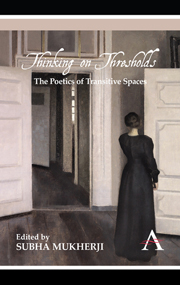Book contents
- Frontmatter
- ACKNOWLEDGEMENTS
- Contents
- List of Illustrations
- Notes on Contributors
- Introduction
- Part One Doors, Windows, Entries
- Part Two Lives and Narratives, Territories and Worlds
- 5 Unsettling Thresholds: Mignon and Her Afterlives
- 6 Dangerous Liaisons: Desire and Limit in The Home and the World
- 7 Writing Through Osmotic Borders: Boundaries, Liminality and Language in Mehmet Yashin's Poetics
- 8 Dancing and Romancing: The Obstacle of the Beach and the Threshold of the Past
- Part Three Matter, Mind, Psyche
- Part Four Reading, Writing, Playing, Listening
- Select Bibliography (including Discography)
7 - Writing Through Osmotic Borders: Boundaries, Liminality and Language in Mehmet Yashin's Poetics
from Part Two - Lives and Narratives, Territories and Worlds
Published online by Cambridge University Press: 05 March 2012
- Frontmatter
- ACKNOWLEDGEMENTS
- Contents
- List of Illustrations
- Notes on Contributors
- Introduction
- Part One Doors, Windows, Entries
- Part Two Lives and Narratives, Territories and Worlds
- 5 Unsettling Thresholds: Mignon and Her Afterlives
- 6 Dangerous Liaisons: Desire and Limit in The Home and the World
- 7 Writing Through Osmotic Borders: Boundaries, Liminality and Language in Mehmet Yashin's Poetics
- 8 Dancing and Romancing: The Obstacle of the Beach and the Threshold of the Past
- Part Three Matter, Mind, Psyche
- Part Four Reading, Writing, Playing, Listening
- Select Bibliography (including Discography)
Summary
In the poem Savaş Zamani (Wartime) the Turkish Cypriot author Mehmet Yashin's (Yaşin) writing self confesses: ‘I was often unsure in which language to shed my tears, / the life I lived wasn't foreign, but one of translation – / my mother-tongue one thing, my motherland another, / and I, again, altogether different…’ Some of the most important threads of Yashin's poetics intersect here in these lines. Mehmet Yashin was born in Nicosia in 1958, when Cyprus was still a politically undivided territory under British colonial rule, but already torn by fierce intercommunal conflicts between the two major ethnic groups populating the island, the Greeks and the Turks. His family is of Turkish origins and Turkish is his mother tongue – the language he learned before any other in what, in another poem entitled Bir Hayalet (A Ghost), he describes as the ‘polyglot house, now silenced’ that he was raised in. And this language still remains the main means of his literary writing. Yet, throughout Yashin's oeuvre, both in his literary works and in his essays, it is possible to trace a constant hesitation about the language he finds more appropriate to resort to in order to express himself, even when his poetical urge leads him to disclose his most intimate sorrows.
Information
- Type
- Chapter
- Information
- Thinking on ThresholdsThe Poetics of Transitive Spaces, pp. 101 - 112Publisher: Anthem PressPrint publication year: 2011
Accessibility standard: Unknown
Why this information is here
This section outlines the accessibility features of this content - including support for screen readers, full keyboard navigation and high-contrast display options. This may not be relevant for you.Accessibility Information
- 1
- Cited by
